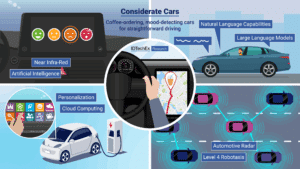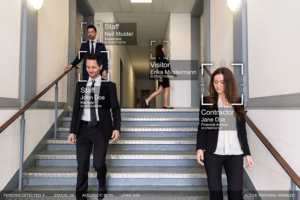Face Detection Functions

AI-enhanced In-cabin Sensing Systems
As the trend of vehicle intelligence enhancement rises, in-cabin sensing systems will be largely responsible for increased communication, sensitivity, and smart features within cars. IDTechEx‘s report, “In-Cabin Sensing 2025-2035: Technologies, Opportunities, and Markets“, provides the latest technology developments within the sector, along with forecasts for their uptake over the next ten years. Where AI meets

D3 Embedded, HTEC, Texas Instruments and Tobii Pioneer the Integration of Single-camera and Radar Interior Sensor Fusion for In-cabin Sensing
The companies joined forces to develop sensor fusion based interior sensing for enhanced vehicle safety, launching at the InCabin Europe conference on October 7-9. Rochester, NY – October 6, 2025 – Tobii, with its automotive interior sensing branch Tobii Autosense, together with D3 Embedded, and HTEC today announced the development of an interior sensing solution

“Understanding Human Activity from Visual Data,” a Presentation from Sportlogiq
Mehrsan Javan, Chief Technology Officer at Sportlogiq, presents the “Understanding Human Activity from Visual Data” tutorial at the May 2025 Embedded Vision Summit. Activity detection and recognition are crucial tasks in various industries, including surveillance and sports analytics. In this talk, Javan provides an in-depth exploration of human activity understanding,… “Understanding Human Activity from Visual

STMicroelectronics and Tobii Enter Mass Production of Breakthrough Interior Sensing Technology
Starting mass production of an advanced interior sensing system for a premium European carmaker for enhanced driver and passenger monitoring Cost-effective single-camera solution combines Tobii’s interior-sensing technology and ST’s imaging sensors to deliver wide-angle, high-quality imaging in daytime and nighttime environments Stockholm, Sweden; Geneva, Switzerland – October 2, 2025 — Tobii, the global leader in

How AI-powered Cameras Are Transforming Data Center Security
This blog post was originally published at e-con Systems’ website. It is reprinted here with the permission of e-con Systems. Data centers process, store, and transmit enormous volumes of data. So, it makes them natural targets for intrusion, sabotage, and other violations. Learn about the importance of AI-based camera surveillance in data centers and their

Next-gen Fleet Telematics and Dashcams Shift to On-device AI
This blog post was originally published at Ambarella’s website. It is reprinted here with the permission of Ambarella. The role of dashcams has changed significantly over the past decade. What began as a passive recording device has become an active, intelligent safety and operations tool. This evolution is being driven by edge AI—the ability to

“Using Computer Vision for Early Detection of Cognitive Decline via Sleep-wake Data,” a Presentation from AI Tensors
Ravi Kota, CEO of AI Tensors, presents the “Using Computer Vision for Early Detection of Cognitive Decline via Sleep-wake Data” tutorial at the May 2025 Embedded Vision Summit. AITCare-Vision predicts cognitive decline by analyzing sleep-wake disorders data in older adults. Using computer vision and motion sensors coupled with AI algorithms,… “Using Computer Vision for Early

Alif Semiconductor Demonstration of Face Detection and Driver Monitoring On a Battery, at the Edge
Alexandra Kazerounian, Senior Product Marketing Manager at Alif Semiconductor, demonstrates the company’s latest edge AI and vision technologies and products at the 2025 Embedded Vision Summit. Specifically, Kazerounian demonstrates how AI/ML workloads can run directly on her company’s ultra-low-power Ensemble and Balletto 32-bit microcontrollers. Watch as the AI/ML AppKit runs real-time face detection using an

Microchip Technology Demonstration of Real-time Object and Facial Recognition with Edge AI Platforms
Swapna Guramani, Applications Engineer for Microchip Technology, demonstrates the company’s latest edge AI and vision technologies and products at the 2025 Embedded Vision Summit. Specifically, Guramani demonstrates her company’s latest AI/ML capabilities in action: real-time object recognition using the SAMA7G54 32-bit MPU running Edge Impulse’s FOMO model, and facial recognition powered by TensorFlow Lite’s Mobile

Considerate Cars: Making Calls for Coffee and Keeping Drivers Alert
Caffeine ready to collect as the car decides to pull over to charge could become the normality of the future, as software-defined vehicle technology and the presence of AI within vehicles advances. IDTechEx’s portfolios of Robotics & Autonomy and Semiconductors, Computing & AI research reports cover passenger safety and increased comfort, while the research onElectric

How Driver Monitoring Cameras Improve Driving Safety and Their Key Features
This blog post was originally published at e-con Systems’ website. It is reprinted here with the permission of e-con Systems. Driver monitoring cameras have become widely accepted as a force in improving road safety. They go a long way to address the risks associated with driver inattention and fatigue by helping continuously observe driver behavior.

Namuga Vision Connectivity Demonstration of an AI-powered Total Camera System for an Automotive Bus Solution
Min Lee, Business Development Team Leader at Namuga Vision Connectivity, demonstrates the company’s latest edge AI and vision technologies and products at the 2025 Embedded Vision Summit. Specifically, Lee demonstrates his company’s AI-powered total camera system. The system is designed for integration into public transportation, especially buses, enhancing safety and automation. It includes front-view, side-view,

STMicroelectronics Introduces Advanced Human Presence Detection Solution to Enhance Laptop and PC User Experience
New technology delivers more than 20% power consumption reduction per day in addition to improved security and privacy ST solution combines market leading Time-of-Flight (ToF) sensors and unique AI algorithms for a seamless user experience Geneva, Switzerland, June 17, 2025 — STMicroelectronics (NYSE: STM), a global semiconductor leader serving customers across the spectrum of electronics

Biometrics in IoT: CyberLink Ports FaceMe to Qualcomm Hexagon NPU for Facial Recognition on Edge Devices
This blog post was originally published at Qualcomm’s website. It is reprinted here with the permission of Qualcomm. If you develop facial recognition software, you spend most of your time and effort maximizing performance, accuracy and precision. Your customers expect high performance, even when running on low-power edge devices like point-of-sale (POS) terminals, kiosks and

Effortless Edge Deployment of AI Models with Digica’s AI SDK (Featuring ExecuTorch)
This blog post was originally published at Digica’s website. It is reprinted here with the permission of Digica. Deploying AI models on mobile and embedded devices is a challenge that goes far beyond just converting a trained model. While frameworks like PyTorch offer a streamlined way to develop deep learning models, efficiently deploying them on

How Face-based Auto Exposure Optimizes Image Quality
This blog post was originally published at e-con Systems’ website. It is reprinted here with the permission of e-con Systems. Face-Based Auto Exposure (AE) technology helps enhance the exposure of faces within the frame. That way human subjects are clearly visible. Find out how this advanced exposure technique works, its features, as well as benefits.

Automotive OEMs Integrating AI into In-cabin Sensing
Integration of AI into In-Cabin Sensing – Automotive OEMs Making Full Use of Software to Enable Advanced Features As regulatory frameworks such as the EU’s Advanced Driver Distraction Warning (ADDW) near enforcement, automotive OEMs are increasingly integrating in-cabin sensing technologies with software-defined vehicle architectures. This shift, evident at CES 2025, marks a pivotal moment in

Qualcomm Dragonwing Intelligent Video Suite Modernizes Video Management with Generative AI at Its Core
This blog post was originally published at Qualcomm’s website. It is reprinted here with the permission of Qualcomm. Video cameras generate a lot of data. Companies that use a video management system (VMS) are left wanting to get more value out of all the video data they generate, enabling them to take the actions that

